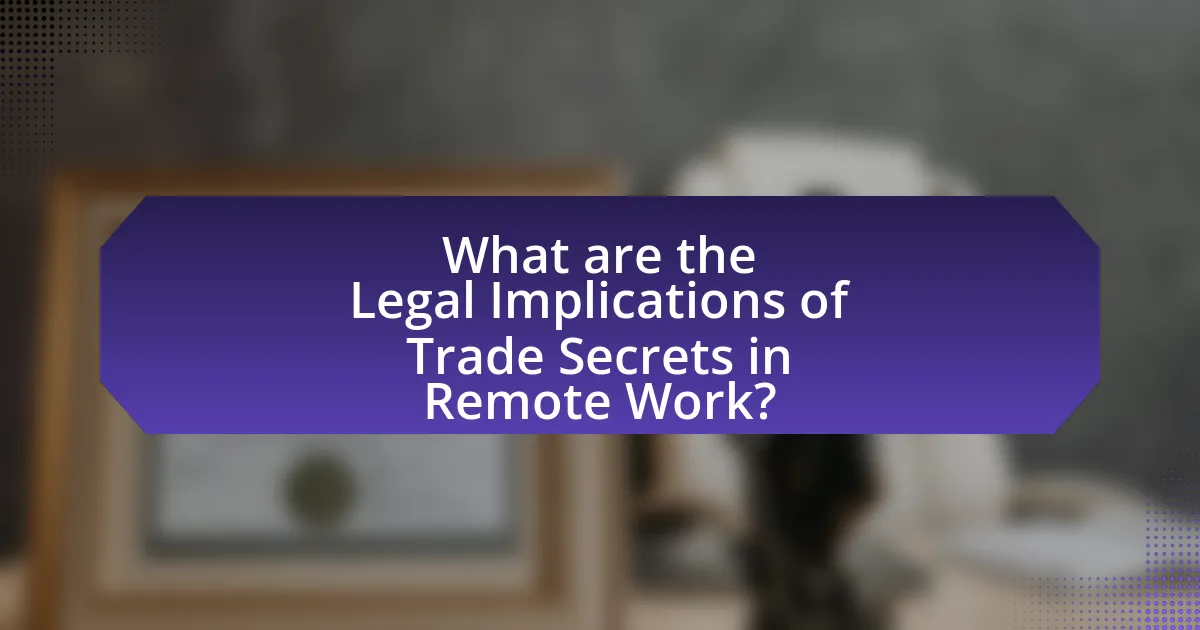Trade secrets are confidential business information that provide a competitive advantage, particularly in the context of remote work. This article examines the legal definitions and criteria for trade secrets, the importance of protecting them, and the unique challenges posed by remote work environments. It highlights the increased risks of unauthorized access and disclosure, the role of technology in safeguarding sensitive information, and the legal implications under the Uniform Trade Secrets Act and the Defend Trade Secrets Act. Additionally, it outlines best practices for organizations to adapt their strategies for trade secret protection in remote settings, emphasizing the need for robust cybersecurity measures and employee training to mitigate risks.

What are Trade Secrets in the Context of Remote Work?
Trade secrets in the context of remote work refer to confidential business information that provides a competitive edge and is not generally known to the public. This includes proprietary processes, formulas, customer lists, and marketing strategies that companies must protect, especially when employees work from home or other remote locations. The risk of unauthorized access or disclosure increases in remote settings, making it crucial for organizations to implement robust security measures, such as non-disclosure agreements and secure communication channels, to safeguard these valuable assets.
How are Trade Secrets defined legally?
Trade secrets are legally defined as information that is not generally known or reasonably ascertainable, which provides a business advantage over competitors who do not know or use it. The Uniform Trade Secrets Act (UTSA) and the Defend Trade Secrets Act (DTSA) in the United States establish that trade secrets must be subject to reasonable efforts to maintain their secrecy, such as confidentiality agreements and security measures. These legal frameworks protect trade secrets from misappropriation, ensuring that businesses can safeguard their proprietary information and maintain a competitive edge.
What distinguishes Trade Secrets from other forms of intellectual property?
Trade secrets are distinguished from other forms of intellectual property by their lack of formal registration requirements and their reliance on confidentiality to maintain value. Unlike patents, copyrights, and trademarks, which require public disclosure and registration with governmental bodies, trade secrets remain protected as long as they are kept confidential and provide a competitive advantage. For example, the Coca-Cola formula is a trade secret that has been protected for over a century without any formal registration, demonstrating the effectiveness of confidentiality in safeguarding proprietary information.
What criteria must be met for information to qualify as a Trade Secret?
For information to qualify as a Trade Secret, it must meet three criteria: it must be secret, it must have economic value, and it must be subject to reasonable efforts to maintain its secrecy. The information is considered secret if it is not generally known or readily accessible to others who could obtain economic value from its disclosure or use. Economic value arises when the information provides a competitive advantage over those who do not know or use it. Reasonable efforts to maintain secrecy can include measures such as non-disclosure agreements, restricted access, and security protocols. These criteria are established under the Uniform Trade Secrets Act and the Defend Trade Secrets Act, which provide legal frameworks for the protection of trade secrets in the United States.
Why are Trade Secrets important for businesses?
Trade secrets are crucial for businesses because they provide a competitive advantage by safeguarding proprietary information that can enhance profitability and market position. This confidentiality allows companies to protect unique processes, formulas, customer lists, and marketing strategies from competitors, which can lead to increased innovation and customer loyalty. According to the World Intellectual Property Organization, trade secrets can significantly contribute to a company’s value, as they often represent a substantial portion of a business’s intangible assets. By maintaining the secrecy of these critical elements, businesses can ensure their long-term success and sustainability in a competitive marketplace.
How do Trade Secrets contribute to competitive advantage?
Trade secrets contribute to competitive advantage by providing businesses with exclusive knowledge that is not publicly available, allowing them to differentiate their products or services. This exclusivity enables companies to maintain higher profit margins, as they can offer unique solutions that competitors cannot replicate. For instance, the Coca-Cola formula is a well-known trade secret that has helped the company sustain its market dominance for over a century. By protecting proprietary information through legal means, such as non-disclosure agreements, businesses can safeguard their competitive edge and foster innovation without the risk of imitation.
What risks do businesses face if Trade Secrets are compromised?
Businesses face significant risks if trade secrets are compromised, including financial loss, competitive disadvantage, and reputational damage. Financially, the loss of proprietary information can lead to decreased market share and revenue, as competitors may exploit the stolen information to gain an edge. For instance, a study by the Economic Espionage Act indicates that U.S. companies lose approximately $300 billion annually due to trade secret theft. Additionally, a compromised trade secret can result in a long-term competitive disadvantage, as rivals may replicate innovative products or processes, undermining the original business’s unique value proposition. Reputational damage also occurs, as stakeholders may lose trust in a company that fails to protect its sensitive information, potentially leading to a decline in customer loyalty and investor confidence.

How has Remote Work Changed the Landscape of Trade Secrets?
Remote work has significantly altered the landscape of trade secrets by increasing the risk of unauthorized access and disclosure. With employees working from various locations, often using personal devices and unsecured networks, the potential for data breaches has escalated. A study by the Ponemon Institute in 2021 found that 70% of organizations experienced a data breach due to remote work practices, highlighting the vulnerabilities associated with remote environments. Additionally, the shift to remote work has necessitated the implementation of more robust cybersecurity measures and policies to protect sensitive information, as traditional in-office safeguards may no longer be effective. This evolution in work dynamics has prompted companies to reassess their trade secret protection strategies, emphasizing the need for comprehensive training and awareness programs to mitigate risks associated with remote access to proprietary information.
What challenges do companies face in protecting Trade Secrets remotely?
Companies face significant challenges in protecting trade secrets remotely due to increased cybersecurity risks and the difficulty of monitoring employee behavior. Remote work environments often lack the robust security measures found in traditional office settings, making sensitive information more vulnerable to cyberattacks. According to a 2021 report by the Ponemon Institute, 61% of organizations experienced a data breach due to remote work vulnerabilities. Additionally, employees may inadvertently share confidential information through unsecured networks or personal devices, further compromising trade secrets. The lack of physical oversight also makes it challenging for companies to enforce compliance with confidentiality agreements and security protocols, increasing the risk of intentional or unintentional disclosures.
How does remote access to information increase the risk of Trade Secret theft?
Remote access to information increases the risk of Trade Secret theft by exposing sensitive data to unauthorized individuals through less secure networks and devices. When employees access proprietary information remotely, they often use personal devices or unsecured Wi-Fi connections, which can be more vulnerable to cyberattacks. According to a 2021 report by Cybersecurity & Infrastructure Security Agency, 85% of organizations experienced a security incident related to remote work, highlighting the increased threat landscape. Additionally, the lack of physical oversight in remote environments can lead to unintentional sharing or mishandling of confidential information, further elevating the risk of Trade Secret theft.
What role does technology play in safeguarding Trade Secrets in a remote environment?
Technology plays a crucial role in safeguarding trade secrets in a remote environment by implementing advanced security measures such as encryption, access controls, and secure communication channels. These technologies protect sensitive information from unauthorized access and potential breaches, which are heightened in remote work settings. For instance, encryption ensures that data transmitted over the internet remains confidential, while access controls limit who can view or modify trade secrets, thereby reducing the risk of internal leaks. Additionally, secure communication tools, like virtual private networks (VPNs) and encrypted messaging platforms, facilitate safe collaboration among remote teams, ensuring that proprietary information is shared securely. According to a report by the Ponemon Institute, organizations that employ robust cybersecurity measures experience 50% fewer data breaches, highlighting the effectiveness of technology in protecting trade secrets in a remote work context.
How can organizations adapt their strategies for Trade Secret protection in remote work settings?
Organizations can adapt their strategies for Trade Secret protection in remote work settings by implementing robust cybersecurity measures and establishing clear remote work policies. Cybersecurity measures should include the use of encryption, secure access controls, and regular security audits to protect sensitive information from unauthorized access. Additionally, organizations should provide training for employees on the importance of safeguarding trade secrets and the specific protocols to follow while working remotely. According to a report by the Ponemon Institute, 60% of data breaches are caused by human error, highlighting the need for comprehensive employee education. Furthermore, organizations can utilize technology solutions such as virtual private networks (VPNs) and secure collaboration tools to ensure that trade secrets remain confidential during remote operations.
What best practices should companies implement to secure Trade Secrets remotely?
Companies should implement strong access controls, encryption, and employee training to secure trade secrets remotely. Access controls limit who can view sensitive information, ensuring that only authorized personnel can access trade secrets. Encryption protects data during transmission and storage, making it unreadable to unauthorized users. Employee training raises awareness about the importance of trade secrets and best practices for safeguarding them, reducing the risk of accidental disclosures. According to the 2021 Global Trade Secrets Survey by the Association of Corporate Counsel, 75% of companies reported that employee training significantly mitigates the risk of trade secret theft.
How can employee training enhance the protection of Trade Secrets in a remote work culture?
Employee training enhances the protection of trade secrets in a remote work culture by equipping employees with the knowledge and skills to recognize, handle, and safeguard sensitive information. Training programs can include specific modules on identifying trade secrets, understanding the legal implications of disclosure, and implementing best practices for data security, such as using secure communication channels and strong passwords.
For instance, a study by the Ponemon Institute found that organizations with comprehensive security training programs experienced 50% fewer data breaches compared to those without such training. This demonstrates that informed employees are less likely to inadvertently expose trade secrets, thereby reinforcing the organization’s overall security posture in a remote work environment.

What are the Legal Implications of Trade Secrets in Remote Work?
The legal implications of trade secrets in remote work primarily involve the protection of confidential information and the enforcement of non-disclosure agreements. Remote work increases the risk of unauthorized access to sensitive data, as employees may use personal devices and unsecured networks, potentially violating the Uniform Trade Secrets Act, which defines trade secrets and provides legal recourse for misappropriation. Additionally, companies must ensure that remote work policies include robust cybersecurity measures and clear guidelines on handling proprietary information to mitigate risks associated with remote access.
What laws govern Trade Secrets in the context of remote work?
The primary laws governing trade secrets in the context of remote work are the Uniform Trade Secrets Act (UTSA) and the Defend Trade Secrets Act (DTSA). The UTSA, adopted by most states, provides a framework for the protection of trade secrets, defining what constitutes a trade secret and outlining the legal remedies available for misappropriation. The DTSA, enacted at the federal level, allows trade secret owners to file civil lawsuits in federal court for misappropriation, providing additional protections and remedies.
In the context of remote work, these laws apply to the safeguarding of confidential information accessed and utilized by employees working from home or other remote locations. For instance, the DTSA includes provisions that protect trade secrets from being disclosed or used without authorization, regardless of the employee’s physical location. This is particularly relevant as remote work increases the risk of unintentional disclosure or theft of sensitive information through unsecured networks or devices.
The effectiveness of these laws is evidenced by the increasing number of trade secret litigation cases, which highlight the importance of maintaining confidentiality and implementing robust security measures in remote work environments.
How do state and federal laws differ regarding Trade Secret protection?
State and federal laws differ regarding trade secret protection primarily in their scope and enforcement mechanisms. The federal law governing trade secrets is the Defend Trade Secrets Act (DTSA) of 2016, which provides a uniform standard for trade secret misappropriation and allows for federal civil lawsuits. In contrast, state laws, such as the Uniform Trade Secrets Act (UTSA), vary by jurisdiction and may have different definitions, remedies, and statutes of limitations for trade secret claims. For example, while the DTSA allows for ex parte seizure of property to prevent further misappropriation, not all states provide such a remedy under their laws. This divergence can lead to inconsistencies in how trade secrets are protected and enforced across different states.
What legal actions can companies take if their Trade Secrets are misappropriated?
Companies can pursue several legal actions if their trade secrets are misappropriated, including filing a lawsuit for misappropriation of trade secrets under the Uniform Trade Secrets Act or the Defend Trade Secrets Act. These legal frameworks allow companies to seek remedies such as injunctions to prevent further use or disclosure of the trade secrets, monetary damages for losses incurred, and in some cases, punitive damages if the misappropriation was willful and malicious. Additionally, companies may report the misappropriation to law enforcement for potential criminal charges against the offending party, as trade secret theft can also constitute a crime under federal and state laws.
How can companies ensure compliance with Trade Secret laws while working remotely?
Companies can ensure compliance with Trade Secret laws while working remotely by implementing robust data protection policies and employee training programs. Establishing clear protocols for handling sensitive information, such as restricting access to trade secrets and utilizing secure communication channels, is essential. Additionally, companies should conduct regular audits to assess compliance with these protocols and ensure that employees understand the legal implications of mishandling trade secrets. According to the Economic Espionage Act, unauthorized disclosure of trade secrets can lead to significant legal consequences, reinforcing the importance of these measures.
What policies should be established to align with legal requirements for Trade Secrets?
To align with legal requirements for Trade Secrets, organizations should establish comprehensive confidentiality policies that clearly define what constitutes a trade secret, outline employee responsibilities regarding the protection of these secrets, and implement training programs on safeguarding sensitive information. These policies must also include protocols for handling and sharing trade secrets, particularly in remote work settings, to prevent unauthorized access or disclosure. For instance, the Uniform Trade Secrets Act provides a legal framework that emphasizes the necessity of reasonable efforts to maintain the secrecy of trade secrets, reinforcing the importance of these policies in compliance with legal standards.
How can organizations monitor compliance effectively in a remote work environment?
Organizations can monitor compliance effectively in a remote work environment by implementing robust digital monitoring tools and establishing clear communication protocols. Digital monitoring tools, such as employee monitoring software, can track user activity, ensuring adherence to company policies and regulatory requirements. For instance, a study by the International Journal of Information Management found that 70% of organizations using such tools reported improved compliance rates. Additionally, regular virtual check-ins and training sessions can reinforce compliance expectations and provide employees with necessary updates on policies. This combination of technology and communication fosters a culture of accountability and transparency, essential for maintaining compliance in a remote setting.
What practical steps can businesses take to protect Trade Secrets in the era of remote work?
Businesses can protect trade secrets in the era of remote work by implementing robust cybersecurity measures, establishing clear access controls, and conducting regular employee training on confidentiality. Cybersecurity measures such as using virtual private networks (VPNs), encryption, and secure file-sharing platforms help safeguard sensitive information from unauthorized access. Access controls ensure that only employees who need specific information for their roles can access it, thereby minimizing exposure. Regular training reinforces the importance of protecting trade secrets and educates employees on best practices, which is crucial as studies show that human error is a leading cause of data breaches. According to a report by IBM, 95% of cybersecurity breaches are due to human error, highlighting the need for ongoing education and vigilance.



